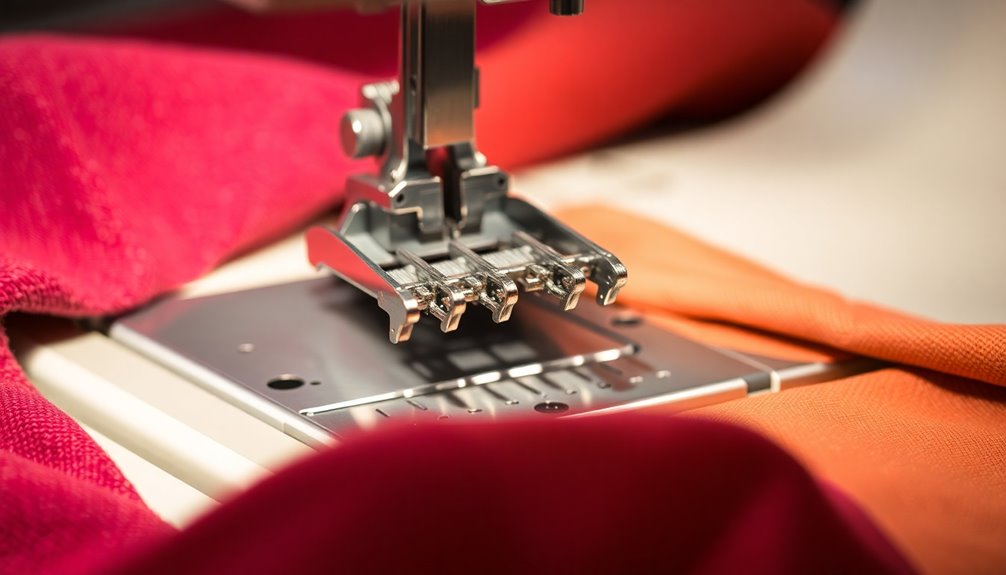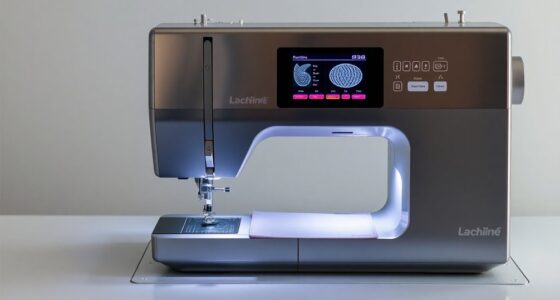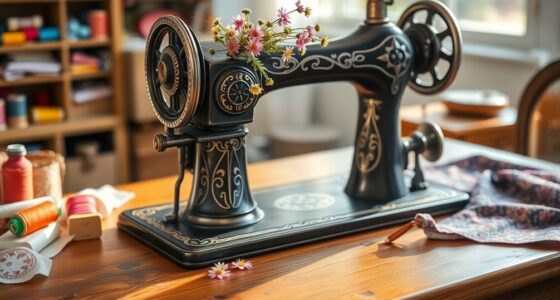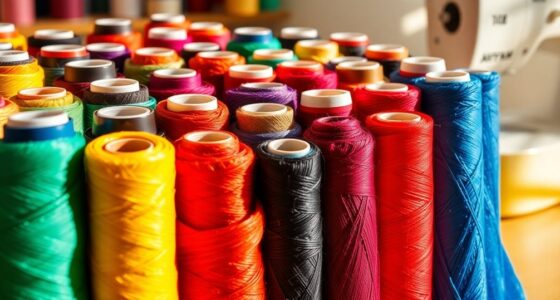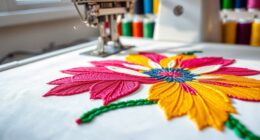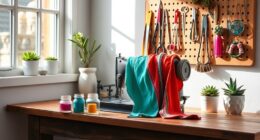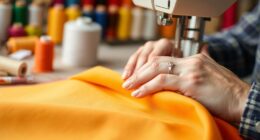A feed dog on a sewing machine is a small, serrated metal piece located under the needle plate. It grips the fabric and moves it forward and backward, ensuring even stitching and precision. You can lower them for free-motion sewing or keep them raised for standard sewing. Regular maintenance and proper use can improve your sewing experience. Discover more about managing feed dogs and how they interact with your machine to enhance your skills.
Key Takeaways
- Feed dogs are serrated metal components beneath the needle plate that guide fabric during sewing.
- They facilitate precise fabric movement with an up-and-down and front-to-back motion for even stitching.
- Adjusting the stitch length alters the feed dog movement, impacting seam quality and precision.
- Feed dogs can be lowered for free-motion sewing, allowing for greater control of fabric.
- Regular maintenance, such as cleaning and inspection, ensures optimal performance and prevents sewing issues.
What Are Feed Dogs?

Feed dogs are the unsung heroes of your sewing machine.
These small, serrated metal pieces sit beneath the needle plate and play a vital role in guiding your fabric as you sew. With a unique up-and-down and front-to-back motion, feed dogs grip the fabric and advance it toward the needle, ensuring precision and even stitching.
When not in use, they can drop below the needle plate, thanks to a feature called drop feed. Depending on the model, feed dogs can vary in design, with modern sewing machines often featuring multiple rows of teeth for better fabric handling.
Understanding feed dogs is essential for anyone looking to master their sewing projects effectively.
How Do Feed Dogs Work?

Feed dogs work by gripping the fabric and moving it forward and backward as you sew.
You can adjust the stitch length using a lever or dial, which changes how high and how far the feed dogs move.
This mechanism is essential for ensuring your stitching is even and precise, so understanding it can really enhance your sewing experience.
Fabric Movement Mechanism
While you sew, the fabric moves smoothly under the needle thanks to the feed dogs, which are small serrated metal pieces located beneath the needle plate.
These feed dogs grip the fabric and operate in a front-to-back and up-and-down motion, advancing it toward the needle. This movement guarantees even stitching and consistent seam quality.
At the end of their stroke, there's a recess that allows the fabric to be released before the feed dogs return to their starting position for the next cycle. This precise mechanism is essential for maintaining straight seams and stitch quality.
Stitch Length Control
Understanding how stitch length is controlled helps you master your sewing machine's capabilities.
The stitch length is adjusted using a lever or dial that alters the movement of the feed dogs. These feed dogs grip the fabric and advance it while the needle creates stitches. By changing the up-and-down motion of the feed dogs, you can vary how much fabric is pulled through with each stitch, allowing for different stitch lengths.
Some machines even allow reverse feed dog motion, letting you pull the fabric backward to create backstitches for reinforcement.
When to Lower Feed Dogs
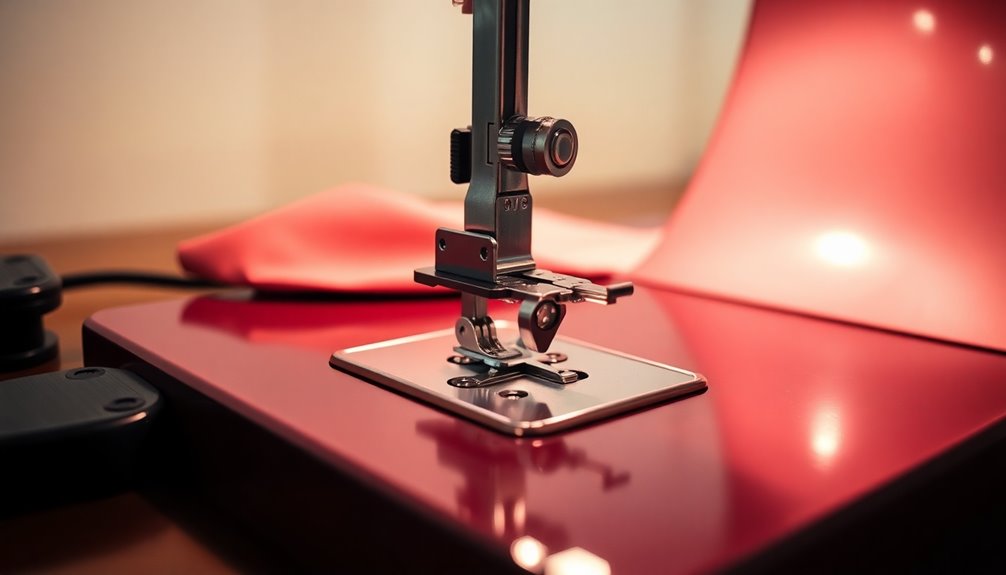
Knowing when to lower your feed dogs can transform your sewing projects.
You'll want to make this adjustment for freehand techniques and creative stitching to gain better control over your fabric.
Whether you're tackling embroidery or steering through curves, lowering the feed dogs is key to achieving the results you desire.
Freehand Sewing Techniques
When you want to explore freehand sewing techniques, lowering the feed dogs is essential for gaining full control over your fabric and stitching. This is particularly true for free-motion quilting and embroidery, where unrestricted fabric movement allows for intricate designs.
| Benefits of Lowering Feed Dogs | Techniques to Try |
|---|---|
| Complete stitch control | Free-motion quilting |
| Enhanced creativity | Detailed embroidery |
| Unique pattern creation | Artistic expression |
| Avoids automatic feed issues | Manual fabric handling |
When the feed dogs are down, you can manipulate the fabric in any direction, enhancing your creativity. Just remember to practice and monitor stitch evenness to avoid gaps or bunching. Enjoy the freedom that comes with lowering your feed dogs!
Creative Stitching Control
Lowering the feed dogs can transform your sewing experience by giving you the freedom to manipulate the fabric exactly how you want it.
This adjustment is essential for projects that demand creativity and precision.
Here's when you should lower the feed dogs:
- Freehand quilting: Achieve intricate designs and control stitch length with ease.
- Decorative stitching: Experiment with unique patterns that require manual handling of fabric.
- Embroidery projects: Enhance your ability to position stitches as desired without the machine's grip.
Specialized Project Requirements
To achieve the best results on specialized sewing projects, you'll often find that lowering the feed dogs is a game changer.
For freehand quilting, this allows you to control the fabric's movement and stitch placement, enhancing your creativity.
In embroidery, lowering the feed dogs lets the fabric move in any direction, making intricate designs easier to achieve.
If you're working on decorative stitching techniques like zigzag or satin stitches, you'll benefit from lowered feed dogs to maintain precision.
When sewing buttons, this adjustment keeps the fabric stationary, ensuring accurate placement.
Additionally, certain quilting projects involving curves or small sections also thrive with the feed dogs down, giving you the control you need for flawless results.
How to Identify Feed Dogs on Your Machine
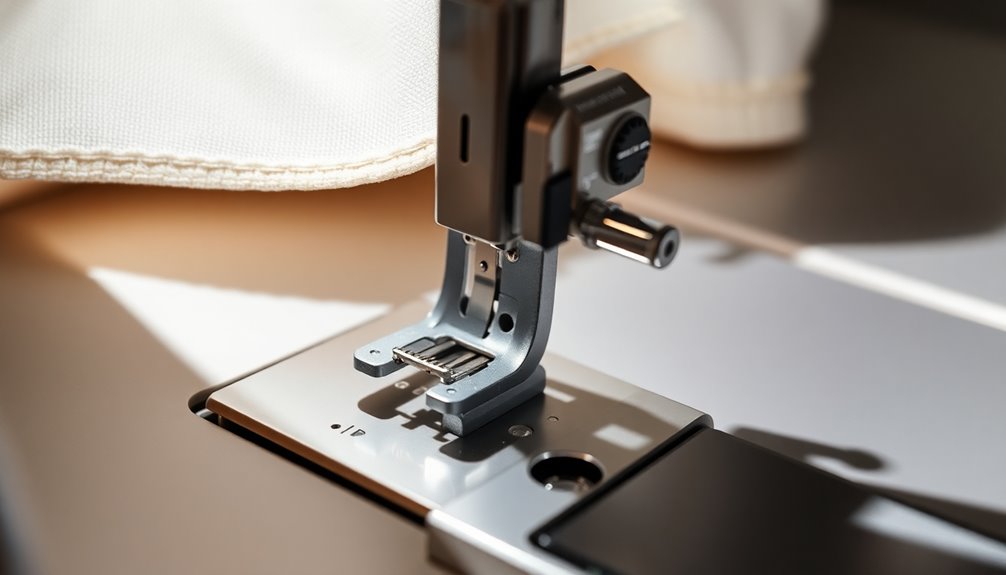
Although identifying the feed dogs on your sewing machine might seem intimidating at first, it's quite straightforward once you know what to look for.
Here's how you can spot them:
- Check Under the Needle Plate – Feed dogs are small, serrated metal components found directly under the needle plate, essential for gripping and moving fabric.
- Look for Symbols – Some machines have symbols resembling triangles or lines, indicating the presence and functionality of feed dogs.
- Inspect Your Accessories – If you have a plastic darning plate in your kit, it can cover the feed dogs when not in use.
For specific details, don't forget to consult your sewing machine's manual to verify you're utilizing the feed dogs effectively.
Features and Benefits of Feed Dogs

Feed dogs play an essential role in your sewing machine's functionality, gripping and moving fabric to create even, precise stitches.
These small, serrated metal components guarantee your fabric shifts smoothly, making them vital for quality sewing. Many modern machines allow you to raise and lower feed dogs, giving you the flexibility to tackle various techniques, like free-motion embroidery or quilting.
Lowering the feed dogs provides full control over fabric movement, perfect for intricate stitching. Additionally, proper adjustment of feed dogs and presser foot pressure can enhance stitch quality and seam straightness, especially when working with different fabric thicknesses.
Specialized Presser Feet for Feed Dogs

When you explore specialized presser feet, you'll discover how they can elevate your sewing experience by working seamlessly with feed dogs.
These feet enhance your sewing techniques and help you achieve creative projects with accuracy. Here are three essential specialized presser feet:
- Darning Foot: Ideal for free-motion quilting and embroidery, it provides an open area for fabric movement.
- Walking Foot: This foot has built-in feeding dogs, ensuring multiple layers of fabric are fed evenly and preventing shifting.
- Stitch Regulator: Found on some models, it maintains consistent stitch lengths during free-motion quilting, enhancing your feed dogs' functionality.
Choosing compatible presser feet with your sewing machine is vital for peak performance and results.
Tips for Proper Use of Feed Dogs

To get the most out of your sewing projects, understanding how to use feed dogs effectively is crucial.
First, adjust the presser foot pressure based on your fabric's thickness to guarantee ideal feeding by the feed dogs. Familiarize yourself with the lever or switch on your machine that raises and lowers the feed dogs for different techniques.
Always test their effectiveness by running scrap fabric through your machine to check for even stitching before starting your main project. Remember, avoid pulling or pushing the fabric while sewing—let the feed dogs control the movement for consistent results.
Finally, regularly inspect your feed dogs for any visible wear or damage to prevent issues like fabric slippage and irregular stitching.
Signs It's Time to Replace Feed Dogs

Sometimes, you might notice your sewing machine isn't performing as well as it used to, and that could mean it's time to replace the feed dogs.
Here are three signs to watch for:
- Fabric Slippage: If your fabric keeps slipping while sewing, the feed dogs may be worn out and can't grip properly.
- Irregular Stitching: Skipped stitches or uneven seams often indicate malfunctioning feed dogs that need replacing.
- Visible Damage: Look for broken teeth or noticeable wear on the feed dogs—this is a clear signal that they should be replaced.
Additionally, if your machine makes unusual noises or struggles with thicker fabrics, it's time for a closer inspection.
Don't wait; replacing those feed dogs can greatly improve your sewing experience!
Building Confidence With Feed Dogs

Building confidence with feed dogs can transform your sewing experience, as they play an essential role in achieving even stitches and consistent fabric feeding.
When working with your sewing machine feed dogs, remember to avoid pulling fabric through; this keeps your stitches aligned and even.
Performing test runs with the feed dogs raised helps you master straight lines and stitch consistency.
If you lower the feed dogs for free-motion techniques, pay close attention to fabric movement to prevent uneven stitching.
Successful machine quilting relies on careful management of feed dogs to avoid gaps or bunching.
With practice, you'll build your skills and confidence, allowing you to tackle more complex sewing projects with ease.
Frequently Asked Questions
What Is a Feed Dog on a Sewing Machine?
A feed dog on a sewing machine is an essential component that helps you move fabric smoothly while sewing.
These small, serrated metal pieces grip the material and advance it under the presser foot toward the needle. You can raise or lower them depending on your sewing needs, which allows for greater control, especially during free-motion quilting.
Understanding how to adjust them can enhance your sewing projects and improve your overall experience.
What Is the Use of Feed Dog?
Think of feed dogs as the rhythm section in a band, keeping the sewing process moving smoothly.
They grip and advance your fabric beneath the needle plate, ensuring even stitches as you sew. By adjusting their motion, you control the stitch length, perfecting your project.
When you want to explore techniques like freehand quilting, you can lower or cover them, allowing creativity to flow without restriction.
They're essential for achieving precision in your sewing.
What Is the Difference Between a Feed Dog and a Presser Foot?
The difference between a feed dog and a presser foot lies in their functions.
Feed dogs grip and move the fabric forward as you sew, working in a back-and-forth motion.
In contrast, the presser foot holds the fabric down, applying pressure to guarantee it feeds evenly without slipping.
While feed dogs are always in motion during sewing, the presser foot can be changed for various techniques, enhancing your sewing experience and results.
What Makes Feed Dogs Move on a Sewing Machine?
Imagine a dancer guiding fabric across the stage—this is what feed dogs do on your sewing machine. They move thanks to the intricate choreography between the machine's motor and the needle's up-and-down rhythm.
As you adjust the stitch length with a lever, you're fine-tuning their performance, dictating how far they'll advance each time. When everything's in sync, your fabric glides smoothly, ensuring each stitch is even and precise.
Conclusion
In the world of sewing, feed dogs are like the unsung heroes of your machine, quietly guiding your fabric as you create. By understanding how they work and when to use them, you can release your sewing potential. Remember to keep them clean and in good shape to guarantee smooth operation. With a little practice and confidence, you'll find that mastering feed dogs can transform your sewing projects from mere fabric into beautiful works of art.
